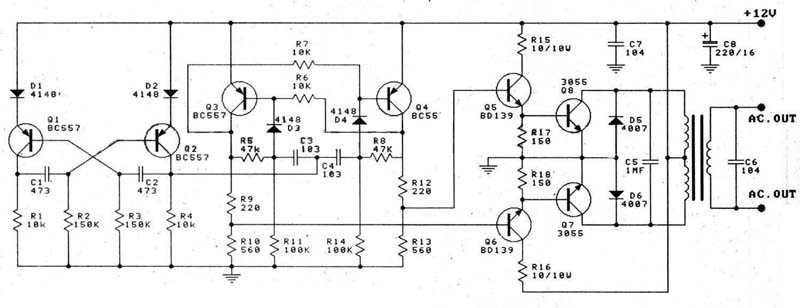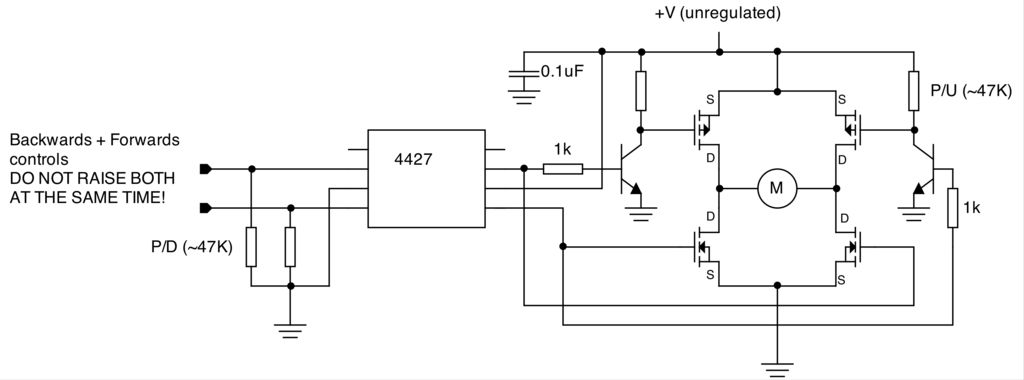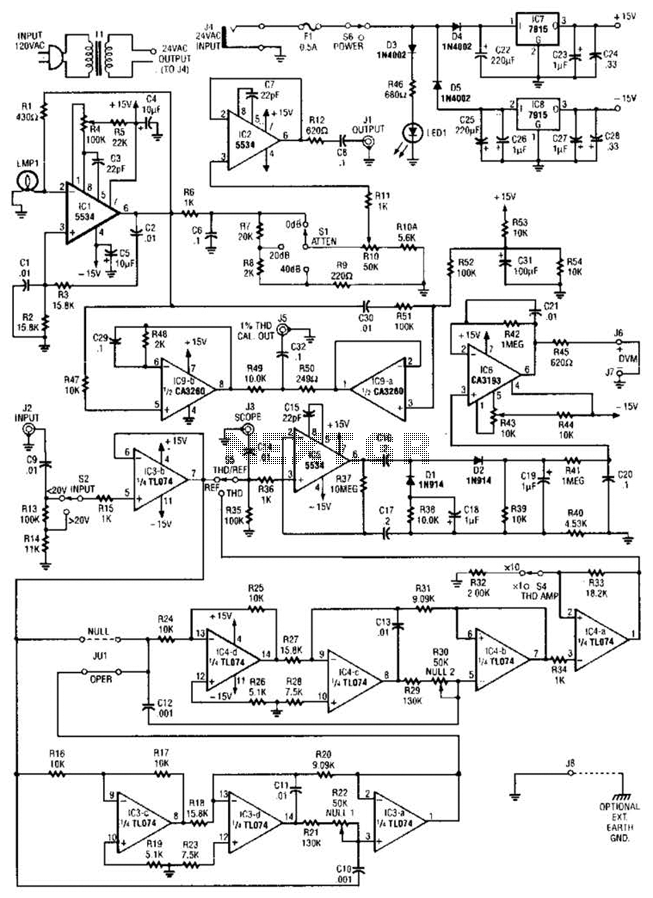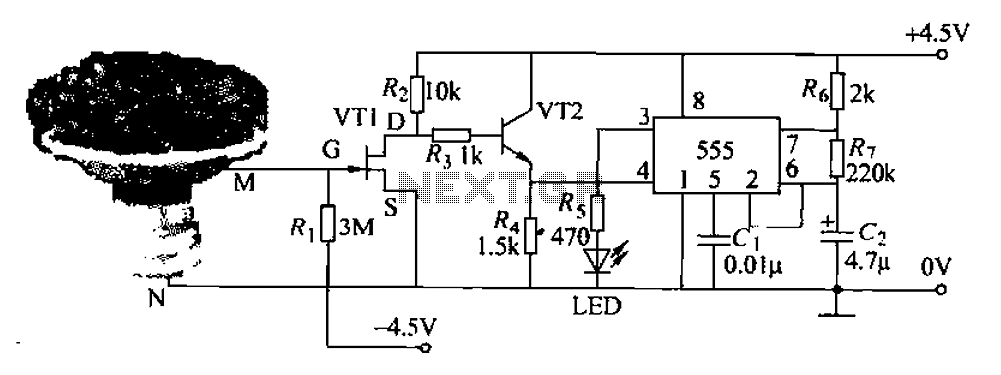
Group items tagged circuit Robotics
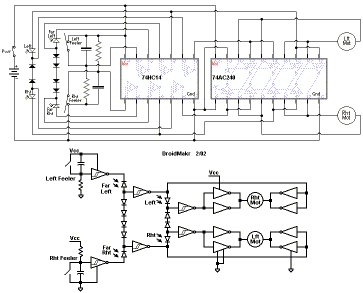
The 1-megohm resistor protects the FET from potential damage caused by accidental sparks to its gate lead. The circuit functions adequately without this resistor; however, it is advised not to intentionally apply a charge to the gate wire using a charged object or a static charge from a finger. To test the circuit, charge a pen or comb using hair and bring it near the small "antenna." The LED should extinguish, and upon removing the electrified pen or comb, the LED should illuminate again. If humidity levels are suspected to be high, this can be verified by rubbing a balloon or plastic object on the arm. If the balloon fails to attract arm hairs, then humidity is too elevated. When encountering an obstacle, the circuit may reverse direction for several seconds. The duration of this reverse can be adjusted; using a 2.2M ohm resistor and a 3.3 µF capacitor results in an approximate reverse time of five seconds. Upon powering on the circuit, it will initially move backward for a brief period. After a few seconds, it appears to hesitate before proceeding towards the brightest light source, initially at a slow pace and then accelerating. Each collision with an obstacle causes it to reverse for a few seconds, with the reverse duration adjustable via a 10 µF electrolytic capacitor—smaller values yield shorter reverse times, while larger values extend them. As long as the light reaching the photo-bridge of the Master SC-H is balanced, the Slave SC-H operates like an independent SC-H. If one of the slave photo-diodes detects more light than the other, the inverter controlling the motor on that side switches states, mirroring the inverter of the Master SC-H connected to the same motor. This action turns off that motor, causing the robot to pivot towards the stronger light source until the light levels at each sensor are balanced, at which point the motor resumes operation. The Slave section incorporates only two diodes (or one LED) between the photo-diodes, enhancing its sensitivity to minor variations in light levels compared to the Master circuit. The system operates effectively; for instance, the robot can chase a beam of light from a flashlight around on the floor, even detecting and responding to the flashlight in a brightly lit laboratory. The tactile switches exhibit strong behavior: when a switch is closed, the robot unconditionally turns away. If both switches are closed, the robot reverses straight back, regardless of light conditions. Although the title suggests that all four photodiodes face forward, the two inner photodiodes are directed straight ahead while the outer two are angled to the left and right.
The circuit described integrates several key components to facilitate light detection and responsive movement. The FET gate protection resistor serves as a critical safeguard, ensuring the longevity and reliability of the circuit. The LED indicator provides immediate feedback on the operational status, illuminating when the circuit is functioning correctly and extinguishing in the presence of an external charge.
The robot's movement is governed by a series of photodiodes that detect light intensity, allowing for dynamic responses to environmental changes. The Master SC-H and Slave SC-H configurations enable the robot to navigate towards brighter light sources effectively, utilizing inverters that control motor functions based on light detection. The adjustable reverse time provided by the capacitor values allows for fine-tuning of the robot's behavior, making it adaptable to different environments and conditions.
The tactile switches add an additional layer of interaction, allowing the robot to respond to physical obstacles by reversing direction. This feature enhances the robot's navigational capabilities, ensuring it can maneuver around barriers without causing damage to itself or its surroundings.
Overall, the design demonstrates a sophisticated interplay between light sensing, motor control, and obstacle avoidance, resulting in a responsive and engaging robotic system. The careful selection of components and their arrangement within the circuit contribute to its functionality and effectiveness in various lighting conditions and physical environments.The 1-meg resistor helps protect the FET from being harmed by any accidental sparks to its Gate lead. The circuit will work fine without this resistor. Just don`t intentionally "zap" the Gate wire with a charged object or your charged finger. To test the circuit, charge up a pen or a comb on your hair, then wave it close to the little "antenna" wi
re. The LED should go dark. When you remove the electrified pen or comb, the LED should light up again. If you suspect that humidity is very high, test this by rubbing a balloon or a plastic object upon your arm. If the balloon does not attract your arm hairs, humidity is too high. When bumbing into something it can also reverse for several seconds. The time of going reverse can be changed. I`ve used 2M2 and 3, 3 uF, this will give a reverse time of about 5 seconds When you "power on" Bully it will first go backwards for some time.
After a few seconds it seems that it doesn`t know what to do, it looks like it`s shivering. Then it starts of going to the brightest lightspot it can see, first slowly and then like "in a hurry". In the time doing all this stuff, each bump into a obstacle makes it move backwards for a few seconds.
The time doing this can be changed with the 10 uF elco. Smaller means less seconds and bigger means reversing for more seconds. As long as the light reaching the photo-bridge of the Master SC-H is balanced, then the Slave SC-H acts as a regular, lone SC-H would. So, if one of the slave photo-diodes detects more light then the other, the inverter that controls the motor on that side changes states and is now the same as the inverter of the Master SC-H tied to the same motor.
This turns that motor off and the robot will pivot around the stopped wheel toward the greater light source until the light on each sensors is balanced and the motor again begins to turn. The Slave section has only two diodes (or one LED) between the photo-diodes. This makes it respond to smaller differences in light levels than does the Master part of the circuit Cheesy works very well.
I ve had fun making him chase a spot of light from a flashlight around on the floor. He has even been able to detect and react to the flashlight spot on the floor of the brightly lighted lab where I work. The tactiles switches behave even more strongly: if a switch is closed then the bot turns away unconditionally.
If both switches are closed the robots reverse straight back regardless of light level. From the title it would appear that all 4 photodiodes face forward but the 2 inner PD s face directly forward and the outer 2 are angled to the left and right 🔗 External reference
The circuit described integrates several key components to facilitate light detection and responsive movement. The FET gate protection resistor serves as a critical safeguard, ensuring the longevity and reliability of the circuit. The LED indicator provides immediate feedback on the operational status, illuminating when the circuit is functioning correctly and extinguishing in the presence of an external charge.
The robot's movement is governed by a series of photodiodes that detect light intensity, allowing for dynamic responses to environmental changes. The Master SC-H and Slave SC-H configurations enable the robot to navigate towards brighter light sources effectively, utilizing inverters that control motor functions based on light detection. The adjustable reverse time provided by the capacitor values allows for fine-tuning of the robot's behavior, making it adaptable to different environments and conditions.
The tactile switches add an additional layer of interaction, allowing the robot to respond to physical obstacles by reversing direction. This feature enhances the robot's navigational capabilities, ensuring it can maneuver around barriers without causing damage to itself or its surroundings.
Overall, the design demonstrates a sophisticated interplay between light sensing, motor control, and obstacle avoidance, resulting in a responsive and engaging robotic system. The careful selection of components and their arrangement within the circuit contribute to its functionality and effectiveness in various lighting conditions and physical environments.The 1-meg resistor helps protect the FET from being harmed by any accidental sparks to its Gate lead. The circuit will work fine without this resistor. Just don`t intentionally "zap" the Gate wire with a charged object or your charged finger. To test the circuit, charge up a pen or a comb on your hair, then wave it close to the little "antenna" wi
re. The LED should go dark. When you remove the electrified pen or comb, the LED should light up again. If you suspect that humidity is very high, test this by rubbing a balloon or a plastic object upon your arm. If the balloon does not attract your arm hairs, humidity is too high. When bumbing into something it can also reverse for several seconds. The time of going reverse can be changed. I`ve used 2M2 and 3, 3 uF, this will give a reverse time of about 5 seconds When you "power on" Bully it will first go backwards for some time.
After a few seconds it seems that it doesn`t know what to do, it looks like it`s shivering. Then it starts of going to the brightest lightspot it can see, first slowly and then like "in a hurry". In the time doing all this stuff, each bump into a obstacle makes it move backwards for a few seconds.
The time doing this can be changed with the 10 uF elco. Smaller means less seconds and bigger means reversing for more seconds. As long as the light reaching the photo-bridge of the Master SC-H is balanced, then the Slave SC-H acts as a regular, lone SC-H would. So, if one of the slave photo-diodes detects more light then the other, the inverter that controls the motor on that side changes states and is now the same as the inverter of the Master SC-H tied to the same motor.
This turns that motor off and the robot will pivot around the stopped wheel toward the greater light source until the light on each sensors is balanced and the motor again begins to turn. The Slave section has only two diodes (or one LED) between the photo-diodes. This makes it respond to smaller differences in light levels than does the Master part of the circuit Cheesy works very well.
I ve had fun making him chase a spot of light from a flashlight around on the floor. He has even been able to detect and react to the flashlight spot on the floor of the brightly lighted lab where I work. The tactiles switches behave even more strongly: if a switch is closed then the bot turns away unconditionally.
If both switches are closed the robots reverse straight back regardless of light level. From the title it would appear that all 4 photodiodes face forward but the 2 inner PD s face directly forward and the outer 2 are angled to the left and right 🔗 External reference
